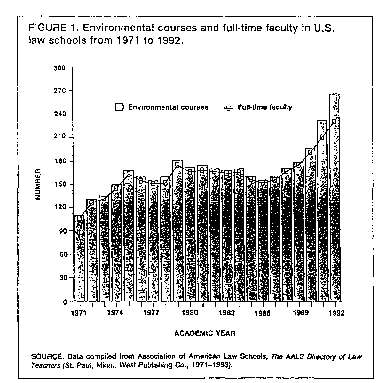
126
60
4.In the late 1980s, law schools again responded to an extraordinary new burst of student interest in
environmental law. In the last six years, there has been a 69-percent increase in the number of
environmental courses taught by full-time faculty in law schools and a 60-percent increase in the number
65
of faculty teaching such courses. In just the last three academic years, the number of environmental courses
has increased by 48 percent, and the number of full-time faculty teaching such courses has increased by 40
70
percent. As a result, the growth of environmental courses and faculty has substantially outpaced growth in
law school enrollments (see Figures 2 and 3 on pages 225 and 226). The number of students enrolled at law
schools approved by the American Bar Association (ABA) increased by 43 percent from 1971 to 1992, but
75
the number of environmental courses at law schools increased by 138 percent. In the 1986 academic year,
there were only 1.27 environmental courses per 1,000 students en rolled in ABA-approved law schools,
but, by 1992, there were 1.93 courses per 1,000 students. Although the number of ABA-approved law
80
schools increased by less than 20 percent from 1971 to 1992 (from 147 to 176), the number of full-time
law school faculty teaching environmental law increased by nearly 120 percent (from 109 to 238). In 1986,
there were only 0.85 full-time environmental faculty per school, but, by 1992, this ratio had risen to 1.35.

